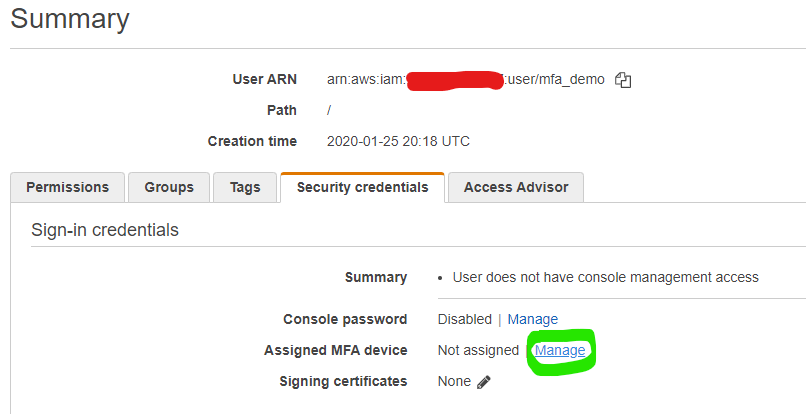If you’re planning on using AWS efficiently, you’re going to want to automate with the CLI, various SDKs and/or the relatively newly released Cloud Development Kit (AWS-CDK). This typically requires an access key pair, providing access to your account, and in need of being secured against abuse. Adding MFA capabilities to the account reduces a lot of risk, it works seamlessly with the web console UI, but can cause some confusion when dealing with CLI access.
For succinctness I’m going to assume that you have an existing user, and associated access keys already. Your ~/.aws/credentials will look like the below (relevant keys will be removed by the time this is posted):
[mfa-demo]
aws_access_key_id = AKIAQOEN7NXFSJGCSB24
aws_secret_access_key = NzPMANXBqFDfh7YwkYpIPBgbET94QFg75eswzG7l
region = eu-west-1Permissions
For the sake of this demo, we’re going to duplicate the Admin policy (below) granting near God-like access to your AWS account. Note, you probably don’t want to do this in the real world as it clearly makes a mockery of principal of Least Privilege, but works for a demo is is clearly a privileged account that we’d want to do our utmost to lock down and keep out of hostile hands.
{
"Version": "2012-10-17",
"Statement": [
{
"Sid": "GodLikePermissions",
"Effect": "Allow",
"Action": "*",
"Resource": "*"
}
]
}AWS CLI
Using the AWS CLI tool, you can now do anything your user has permission to do; which with the permissions above, is just about anything. For example:
awaite@Armitage:/tmp$ aws --profile mfa-demo s3 ls
2019-09-28 20:55:13 <redacted>
2019-09-28 20:56:03 <redacted>
[--snip--]Adding MFA token
Adding an MFA token is handled from the user’s security credentials page, below. If you’ve ever used virtual MFA tokens for literally any other service, then the process should self explanatory.

Job done?
Unfortunately not, the access key pair above will still provide access just as they did above.
Deny access without MFA
Logical order of IAM policy causes an explicit deny to take priority over any competing policy statement. With this, we can add a policy statement to deny any action requested without MFA. Expanding the sample policy statement above produces:
{
"Version": "2012-10-17",
"Statement": [
{
"Sid": "Permissions",
"Effect": "Allow",
"Action": "*",
"Resource": "*"
},
{
"Sid": "DenyNonMFA",
"Effect": "Deny",
"Action": "*",
"Resource": "*",
"Condition": {
"BoolIfExists": {
"aws:MultiFactorAuthPresent": "false"
}
}
}
]
}And running the same cli command, now throws an error:
awaite@Armitage:/tmp$ aws --profile mfa-demo s3 ls
An error occurred (AccessDenied) when calling the ListBuckets operation: Access DeniedRequesting session token with MFA
To recap, we now have a user with the same permissions as before, but unable to utilise them without verifying ownership with the matching MFA token. This is achieved with AWS’s Security Token Service, specifically get-session-token function. From the commandline:
- –serial-number: arn for the MFA token assigned to your user.
- –token-code: MFA token code
- [optional] –duration: lifetime for the token to remain valid, in seconds (default is 1hr)
awaite@Armitage:/tmp$ aws --profile mfa-demo sts get-session-token --serial-number arn:aws:iam::<account_number>:mfa/mfa_demo --token-code 987654
{
"Credentials": {
"SessionToken": "FwoGZXIvYXdzEPb//////////wEaDEioLK19BAZ+rPCosiKGAa2cfjZK99HUj8e9w9ZowKuz5ccWo8t3oSBaSiTv70Km0uYigFWXEa1EVjzcf2PD8LYR4paAeaJrLY+8q4MVmWVslYMskVPh22TdLxF24yEaELq/MBlbBnvBwDH37tTvd8nQlD/jXsmI00ludQh4XRUbhzV+76dUgZG9BcLRB47/ClThsp47KPjYsvEFMijGo2SOHNI8xh16TFJnLIZyx4qZ9Y0A65eugu0CnclDT01KoWnLIC1x",
"Expiration": "2020-01-26T09:00:40Z",
"AccessKeyId": "ASIAQOEN7NXF7VSXV45K",
"SecretAccessKey": "kfr9bELctF7okIUSSylmwepLI9jJDEH9gcaNNbML"
}
}Once obtained, credentials need adding into your ~/.aws/credentials file, note the additional aws_session_token variable:
[mfa-session]
aws_access_key_id = ASIAQOEN7NXF7VSXV45K
aws_secret_access_key = kfr9bELctF7okIUSSylmwepLI9jJDEH9gcaNNbML
aws_session_token = FwoGZXIvYXdzEPb//////////wEaDEioLK19BAZ+rPCosiKGAa2cfjZK99HUj8e9w9ZowKuz5ccWo8t3oSBaSiTv70Km0uYigFWXEa1EVjzcf2PD8LYR4paAeaJrLY+8q4MVmWVslYMskVPh22TdLxF24yEaELq/MBlbBnvBwDH37tTvd8nQlD/jXsmI00ludQh4XRUbhzV+76dUgZG9BcLR$region = eu-west-1And with that, we’re back to being able to work with the CLI, more confident that we’re the only ones using this key:
awaite@Armitage:/tmp$ aws --profile mfa-session s3 ls
2019-09-28 20:55:13 <redacted>
2019-09-28 20:56:03 <redacted>For more information, a couple of AWS KnowledgeBase and documentation articles proved useful getting all the pieces lined up correctly:
- https://aws.amazon.com/premiumsupport/knowledge-center/authenticate-mfa-cli/
- https://aws.amazon.com/premiumsupport/knowledge-center/enforce-mfa-other-account-access-bucket/
- https://docs.aws.amazon.com/IAM/latest/UserGuide/tutorial_users-self-manage-mfa-and-creds.html
—
Andrew
Leave a comment